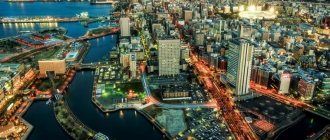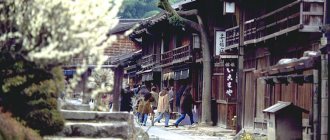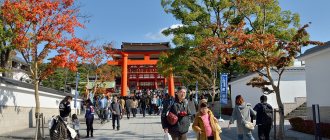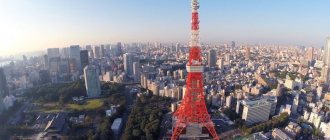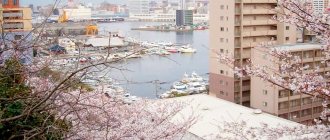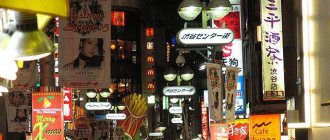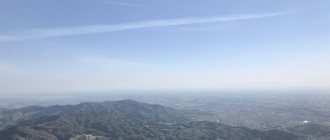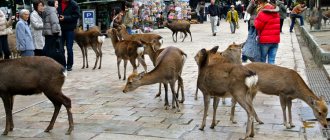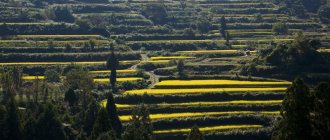Nagoya Castle
Nagoya Castle is located in Nagoya City, Aichi Prefecture.
It would have been founded as a residence in 1612 for Yoshinao Tokugawa, the son of Ieyasu Tokugawa. It was burned during the war, but reconstructed in 1959. The castle structure consists of chain towers with five layers of large and small towers. The castle is famous for its green roof and golden satihoko (mythological fish), and is also a symbol of the city of Nagoya. The Castle, Nagoya's main attraction The tallest tower extends seven floors upward, with an observation room on the seventh floor.
On the third and fifth floors there is an exhibition of life-size satihoko models. Visitors can also experience what it is like to live inside and outside the castle, use stone tools and move around on kagos (large baskets). Here you can simultaneously admire the views of the castle and learn the history of the city. On the ground floor are painted images on sliding paper doors and other artifacts such as swords and military equipment.
Tokugawa Garden
Tokugawa Garden is a Japanese-style garden located in Nagoya, Aichi Prefecture, Higashi District. Originally the mansion of the Owari Tokugawa family, there are still ruins of a samurai residence at the main gate. Adjacent to the garden is the Tokugawa Art Museum, which displays scrolls of The Tale of Genji, as well as the Hosabunko Nagoya-shi Library, which houses manuscripts of The Tale of Genji.
At the center of the garden is a pond that symbolically represents the natural landscape of Japan, a simplified version of a waterfall flowing into the ocean. The gardens of the Daimyo of the Edo period (1603-1868) were also created primarily in this style.
Tokugawa Gardens has a rich landscape, and here you can feel the grandeur of the Daimyo's gardens. Tourists can enjoy various terrains, including forests and rocks. Here you can admire the four seasons - peonies bloom in April, irises from early to late June, and yellowing leaves appear at the end of November. This is a great place to relax after an exciting tour of Nagoya.
NAGOYA
NAGOYA, city in Japan, adm. center of Aichi Prefecture. Us. OK. 2.27 million people (2012; the fourth most populous city in the country after Tokyo, Yokohama and Osaka); N. is the core of the mountains. agglomeration (pop. over 8.9 million people), which is part of the Tokaido megalopolis (a chain of agglomerations in the south of Honshu Island - from Tokyo to Osaka and Kobe). The center is located in the south. parts o. Honshu, on the Nobi Plain, near the north. coast hall Ise. An important transport hub, including the Tomei (Tokyo - Komaki), Isewangan (Toyota - Yokkaichi) and Higashi-Meihan (Nagoya - Kameyama) expressways; The Tokaido (Tokyo - Osaka) high-speed railway line passes through N. D. "Shinkansen". The largest in Japan and one of the largest in the world. ports. Ferry service to the cities of Sendai (eastern coast of Honshu) and Tomakomai (Hokkaido). Intl. Chubu Center Airport (2005; on an artificial island off the eastern coast of Ise Bay, south of N.); Komaki Airport (1944; north of the city; domestic flights). Metropolitan (since 1957; 6 lines).
The settlement was formed around a castle built in 1610–12 (area 35 hectares) by the founder of the Tokugawa shogun dynasty, Tokugawa Ieyasu (shogun in 1603–16). In subsequent years, political center prov. Owari is the domain of one of the side branches of the Tokugawa clan. In 1871, as a result of adm. reforms became part of Nagoya Prefecture, since 1872 in Aichi Prefecture; since 1889 city status. From the end 19th century large trade and industrial center (textile, food industry, production of ceramic products). In 1907, the city of Atsuta was included in Nizhny Novgorod. During World War II, the city suffered greatly from American raids. aviation (Dec. 1944 - May 1945), restored towards the end. 1950s
In the center of N. there is a regular layout of the beginning. 17th century (saved during the restoration of the city). In its northern part of the Nagoya Castle is located (partially destroyed in 1945, restored in 1959 from reinforced concrete; now a museum) with the Ninomaru garden (early 17th century, master of landscape art Kobori Enshu), next to it are the buildings of the Mountains. council (1933, architect Hirabayashi Kingo) and the administration of Aichi Prefecture (1938, architect Watanabe Hitoshi) in the Art Deco style with elements of national. architecture To the south are the TV tower (1954, engineer Naito Tachu, height 180 m), the Toyoda Memorial Hall of Nagoya University (1960, architect Maki Fumihiko), the mountains. artist museum (1983–1987, architect Kurokawa Kisho), Aichi Prefectural Arts Center (1992), multifunctional complex “Oasis 21” in high-tech style with a water-filled glass area covering the area (2002, architect Kasai Hideki). In zap. part of the center of N. there is a railway building. station, completed by the paired skyscrapers “JR Central” (1999, architectural bureau KPF; heights 226 m and 245 m); nearby are high-rise administrative buildings. the Midland Square building (2004–06, the tallest building in N. - 247 m) and the educational building Mode Gakuen Spiral Towers (2005–08, height 170 m; both - Nikken Sekkei architectural bureau). To the south of the center of N. is the Shinto shrine of Atsuta (founded in the 2nd century AD or in the 5th/6th century AD; the existing buildings are mainly from the 20th century; one of the three symbols of imperial power is kept here, the ancient sacred sword "Kusanagi-no-tsurugi") is one of the most ancient and revered in Japan, a center of pilgrimage.
Nagoya. Panorama of the city.
Nizhny Novgorod is a major center of science, education and culture. St. 180 scientific. institutions (a number of them are located in the Sidami Science Park), including Technical. Tokai center (1971), Nagoya city. Institute (1990), N.-i. Institute of Health, Municipal Institute of Industry. Research, Department of National. Institute of Advanced Science and Technology in the Chubu Region (AIST, Tokyo; created on the basis of the National Institute of Industrial Research, founded in 1952); also n.-i. industrial centers companies. In the city of St. 20 universities and other universities, including Nagoya University (1939; it includes the Technological Institute, 1949), Nanzan University (1949), Meizo University (1949), Gor . University (created in 1950 by the union of the Women's Medical Institute and the Pharmaceutical University), Economic. University (1953), Women's University (1964), University of Arts (1970), campuses of Aichi University (1946), Tyuko (1956); technological Institute "Toyota" (1981). Museums: Tokugawa Art Museum (1935), Mt. scientific (1962; includes a planetarium), memorial to Hideyoshi and Kiyomasa (1967; history of the 2nd half of the 16th century), automobile (1989; exhibition of cars from the late 19th to mid-20th centuries), industry and technology (1994 ; both belong to Toyota), glass (1997); branch of the Boston Museum of Fine Arts (opened in 1999), etc. Int. design center (1996; it includes a museum and gallery). Aichi Prefectural Arts Center (includes an art museum, theater, library, etc.). Nagoya Noh Theater (1997). Higashiyama Zoo and Botanical garden (1937). In the port area there is an oceanarium (1992), sea. museum, amusement park. In Nizhny there is the Tunity Dragons baseball club (founded in 1936), which plays at the Nagoya Dome (1997, about 40 thousand seats), and the Nagoya Grampus football club (1991). Held annually: international. women's marathon (in March), professional sumo wrestlers' tournament (in July).
Nagoya. High-rise building "Mode Gakuen Spiral Towers". 2005–08. Architectural bureau "Nikken Sekkei".
Important business and industrial center of Japan. Basic The service sector plays a role in the city’s economy (over 70% of workers are employed, mid-2000s). In N. there is a stock exchange (the third largest in terms of trading volume in Japan), branches of leading national and head offices of regional banks [Aichi Bank (1910), Chukyo Bank (1943), Bank of Nagoya (1949)], large industrial enterprises. companies, including Nippon Sharyo (leading manufacturer of railway rolling stock), Mori Seiki Co. (precision machines). Transport and logistics services are important. Freight turnover at sea port (located in N. and its suburbs) 185 million tons (2010; 218.1 million tons in 2008), of which foreign trade cargo is approx. 110 million tons (import of main liquefied natural gas, iron ore concentrates, oil, coal; export of cars and components for them, other engineering products), also 2.5 million TEU containers (5 container terminals are operating). In 2011, through the international 9.1 million passengers and 151 thousand tons of cargo passed through the airport. Near the regional airport is Komaki Air Base of the Japan Air Self-Defense Force. Exhibition Center: the World Expo 2005 was held here; among the main venues - Congress Center (1990).
N. – industrial center Chuko zones. The leading industry is mechanical engineering (transport, electrical engineering, instrument making, production of industrial equipment, etc.). The Nizhny agglomeration is the most important center of the country's automotive industry. The headquarters (in Toyota) and 12 factories of the Toyota Motor Corporation (one of the world's largest automobile manufacturers), factories of the Mitsubishi Motors Corporation and Mitsubishi Fuso Truck and Bus Corporation (medium-capacity buses) are located here. , as well as many companies producing various. components, components and assemblies, including in N. - head offices and enterprises of the companies "Aichi Machine Industry Co." (engines, etc.), "NGK Spark Plug Co." (spark plug). Aviation is widely represented in the agglomeration. industry (divisions of Mitsubishi Heavy Industries that produce aerospace equipment, including military equipment, other companies). There are also enterprises of the companies "Mitsubishi Heavy Industries Plastic Technology Co." (injection molding machines), Mitsubishi Electric Corporation (power equipment, electronic equipment). In the city - he builds production. equipment and diesel generators (“Nippon Sharyo”), ventilation equipment for villages. farms and industry (“Fulta Electric Machinery Co.”), ind. and household heaters and heating systems, water and gas measuring instruments. In N. is the head office and enterprises of the company “Brother Industries” (printers, fax machines, sewing machines, etc.).
Ferrous (Daido Steel Co., Chubu Steel Plate Co.) and non-ferrous (Sumitomo Light Metal Industries) metallurgy, chemical. (“Mitsui Chemicals” – plastics, synthetic fibers and films, “Toray Industries” – artificial fibers, fire extinguishers, etc., “Toagosei Co.” – nitron, etc.), light (textile, etc.), food flavoring ( including brewery - “Asahi Breweries”), printing, ceramics. (“Noritake Co.” – porcelain products, ceramic products for electronics, etc.; “NGK Insulators” – industrial ceramics) industry. Production of corrugated cardboard and containers (Rengo Co.), building materials (Nichiha Corporation - cement, roofing and facing materials). Traditional crafts, including the manufacture of mechanical "Kakuri Ningyo" dolls.
20 km northeast of the center of N. is the open-air museum Meiji-mura (“Meiji Village”; 1965) with architect. monuments of the Meiji era.
Kakuo-zan Nittai-ji Temple
Kakuo-zan Nittai-ji Temple is located in the Chikusa region. It is the only Buddhist temple in all of Japan that is not associated with any sect of Japanese Buddhism; All 19 sects in Japan use a rotation system in which each sect's high priest serves at the temple for three years.
The temple was founded in 1904 to bury and preserve a stupa that was donated by Thailand (this stupa contains the actual thumb bone of Shakyamuni Buddha).
The tower in which this stupa is kept is made of stone and is an unusual building that combines elements of both Indian and Buddhist architecture.
Nittai-ji Temple is intended to symbolize good relations between the two countries. On its territory there is an image of Rama V, who donated the stupa, as well as a chamber in which you can see the legacy of Thai kings. Every October 23rd, on the anniversary of the founding of the temple, it is tradition that the Thai Ambassador travels to Japan to visit the temple.
Nagoya
Story
Since the Paleolithic era, the territory of the current city has been inhabited by people.
At the beginning of the 17th century, several settlements were located here, the largest of which was the city of Atsuta. To the west of it was the port of Kuwana. In 1610, by order of Tokugawa Izyasu, the unifier of the country, they began the construction of Nagoya Castle, which was built in two years. Soon a settlement grew around it, which eventually became known as Nagoya. At the beginning of October 1889, the settlement received city status. Since the end of the 19th century, Nagoya has become a thriving commercial and industrial center of the country. There are a number of industrial enterprises operating in the modern city. The textile and light industry, chemical and oil refining industries, mechanical engineering and metallurgy are developed here. The Central Commodity Exchange of Japan is active.
Attractions
The castle in Nagoya, one of the most famous in Japan (1610-1612), was destroyed during an American air raid and restored in 1953. Also known is the Atsuta Shinto shrine, which houses the Kusanagi no Mitsurugi - a sacred sword, one of three sacred symbols of the imperial dynasty. The temple has several halls in which about 3,000 historical and cultural treasures are stored.
Not far from the city there is Meiji-mura Park, an open-air museum in which buildings typical of the Meiji era (1868-1912) are collected from all over the country. Including houses that belonged to famous writers of that time - Mori Ogai and Natsume Soseki. There are tram lines along which hundred-year-old carriages run. The park can be reached by regular bus in 1.5 hours.
Urakuen Park, just a five-minute walk from Inuyama Castle, is home to the Joan teahouse, built in 1618 by the monk Urakusai Oda. The Uraku-ryu school of tea drinking that he founded has survived to this day and is considered a classic. In the vicinity of this park is the Japanese Monkey Park (which can be reached in just five minutes by monorail trailer). The park's enclosures are home to thousands of monkeys collected from all over the world.
Nagoya is also known as the birthplace of Nagoya, whose factory and museum you can take a tour of.
Shopping
Nagoya is a renowned center for the production of ceramics, lacquerware, Shibori-zome clothing and other traditional handicrafts. At Nagoya Station Square, underground, there is Japan's largest underground shopping center - a real shopping district.
Meito Museum of Art
This is a private museum located in Aichi Prefecture, Nagakute. It was originally located in Nagoya, but in 1992 it was moved here and reopened as a Japanese-style art museum with a garden.
The museum has a large collection of contemporary Japanese paintings by various artists, including the "3 Great Japanese Artists of Beauty": Shoen Uemura, Kiyokata Kaburagi and Shinsui Ito.
The museum exhibits famous paintings by various artists from the Meiji period (1868-1912) to the Heisei period (1989-present). Among them are Gyokudo Kawai and Taikan Yokoyama. By studying the paintings, you can see how artistic styles have changed over the centuries, and also learn about the history of Japanese paintings.
Toyota Automobile Museum
The Toyota Automotive Museum was built in 1989 as part of the 50th anniversary of the Toyota Motor Cooperation. Celebrating more than 100 years of gasoline-powered automobile history, the permanent exhibition includes not only Toyota vehicles, but also historic vehicles from around the world from the 19th and 20th centuries from a variety of manufacturers.
The museum is divided into the "main building" and the "new building". The main building hosts exhibitions on the origins of the automobile, the development of automotive technology, and the history of automobile culture. The new building highlights the history of Japanese cars and also hosts exhibitions of the company's products.
Night in Nagoya
In Nagoya you can spend the night in different places, in very different price ranges. You can spend the night in youth hostels, hotels or campsites. Hotel prices can vary greatly, but in high season you can expect over €50 per night. Hostels, youth hostels and camping sites are a bit cheaper but also offer far less luxury.
Views: 1,733
Share link:
- Tweet
- Share posts on Tumblr
- Telegram
- More
- by email
- Seal
Liked this:
Like
Shirotori Teien Garden
Shirotori Teien Garden is an authentic Japanese garden located in Atsuku Shirotori Prefectural Park in Nagoya.
This is a walking pond with a path. Among all the public parks in the Tokaj region, this is the largest. The garden is inspired by the landforms of the Chubu region and pays special attention to the 3 Tokai Prefectures (Aichi, Gifu and Mie), recreating their natural grandeur. In the western part there is a hill in the shape of Mount Ontake, and the river flowing into each pond is made in the likeness of the Kiso River. The central pond and adjacent ponds are modeled after Ise Bay.
The "Seiyu-tei" in the main establishment is a full-scale tea house designed in the authentic Sukiya style. It often hosts tea parties and other events. There is another tea house where you can drink matcha tea while admiring the garden.
Jakko-in Temple
Founded in 654, it is the oldest temple in Owari Province. It is well known as a place of power that even Oda Nobunaga visited. The sanctuary is known for its blooming flowers in the spring, green maple leaves in the summer, beautiful colors in the fall, and a languid “aura” in the winter. The leaves are especially beautiful in autumn. So much so that the temple is called "Momiji-in" or "autumn leaf temple." There are about 1000 maples growing around the main hall and every year in autumn they delight the eye with a variety of colors.
Due to the rich natural environment and nature trails that run through the sanctuary's land, it has been designated a national park.
JR-Maglev and Railway Park (SCMAGLEV and Railway Park)
JR-Maglev and Railway Park is a railway-themed museum founded in March 2011 in Nagoya, Aichi Prefecture. JR Tokai, the company that operates the Tokaido Shinkansen, also operates the museum.
At the train exhibition, visitors can see the first Shinkansen of the zero type, the 100, 300 and 700 series. Here you can also see the yellow Shinkansen 922, which is called the “Yellow Doctor”. It is used for railway inspection, so people usually cannot see it from the inside. The 932 series train is the new Yellow Doctor, very popular among visitors due to its rarity.
Also on display here is the JR-Maglev experimental car for the JR-Maglev Shinkansen Central Line, scheduled for production in 2027.
In addition, you can see Hoji 6005, the last steam locomotive in Japan, as well as many other old model trains.
Entertainment and attractions in Nagoya
The castle in Nagoya, one of the most famous in Japan (1610-1612), was destroyed during an American air raid and restored in 1953. Also known is the Atsuta Shinto shrine, which houses the Kusanagi no Mitsurugi - a sacred sword, one of three sacred symbols of the imperial dynasty. The temple has several halls in which about 3,000 historical and cultural treasures are stored.
Not far from the city there is Meiji-mura Park, an open-air museum in which buildings typical of the Meiji era (1868-1912) are collected from all over the country. Including houses that belonged to famous writers of that time - Mori Ogai and Natsume Soseki. There are tram lines along which hundred-year-old carriages run. The park can be reached by regular bus in 1.5 hours.
Urakuen Park, just a five-minute walk from Inuyama Castle, is home to the Joan teahouse, built in 1618 by the monk Urakusai Oda. The Uraku-ryu school of tea drinking that he founded has survived to this day and is considered a classic. In the vicinity of this park is the Japanese Monkey Park (which can be reached in just five minutes by monorail trailer). The park's enclosures are home to thousands of monkeys collected from all over the world.
Nagoya is also known as the birthplace of Nagoya, whose factory and museum you can take a tour of.
Atsuta-jingu Shrine
Atsuta-jingu Shrine, located in the woods of southern Nagoya City, has long been called Atsuta-san. Including tourists in recent years, 6.5 million people visit this place annually.
One of the three sacred treasures mentioned in Japanese mythology, passed from emperor to emperor - Kusanagi no Tsurugi (Kusanagi sword) is buried here. The other two treasures are the mirror and the ball. This shrine became the imperial shrine after the Ise Shrine, which was revered by courtiers and military leaders since ancient times.
In 113 the sword was buried. This year the temple was founded. In 2013, it celebrated its 1900th anniversary.
Guide: Kobe Attractions
Japan. Aichi Prefecture is the heart of Honshu Island. Nagoya. Shopping areas of Oosa and Sakae
Nagoya is one of the largest cities in Japan, second in population only to such well-known cities in the world as Tokyo and Osaka, whose population currently stands at just under 3 million people. So, dear readers, let’s first enjoy the technogenic reality surrounding us, and look at this city (written in three kanji - which in translation sounds something like this - “famous old shop”, a little strange interpretation, unlike Tokyo - - the eastern capital - the logic is present), from the height of the observation deck of the Nagoya Tower, whose height is 245 meters.
The city at night looks fabulous - rushing strings of cars, among which there are German and Swedish ones, flying along all sorts of multi-tiered overpasses and streets, huge color screens with running lines of all kinds of information, and of course, numerous restaurants open until 5 am.
In these numerous restaurants you can have a snack at any moment, and if you wish, you can ask for a fork and spoon, although eating sushi or sashimi with chopsticks is much more pleasant. Let's now look at one of the high-rise buildings in the city, namely the hotel, built in the American style.
Isn't it impressive? In addition, it serves as an excellent reference point for Airbus navigators landing at Nagoya International airport.
In the center of Nagoya there are two huge districts - Oosa and Sakae, where you can buy everything - from a cleaning CD-ROM disk to a 4-processor server, and computer stores and shops can be in very unexpected places, the largest supermarkets go up to 4-7 floors, or are huge basements, where you go down and up by elevators or escalators. In the center of these neighborhoods, in a small park, embodying the progress of computer technology, there is a laser, the beam of which in the evenings is directed at the television tower or goes out as an endless energy beam of photons into the sky.
Necessary information for tourists and travelers who want to visit Japan - the best option is to have a CityBank card with you; in hotels and airports there are ATMs with which you can convert part of the dollars in your account into Japanese yen and immediately receive banknotes. If you want to change cash American dollars, you can only do this at airports, banks or hotels, and currency exchange transactions in banks take place from 9 a.m. to 3 p.m., and the rate is set as yesterday’s on the Tokyo Stock Exchange, minus 3 yen. When exchanging, you need to fill out a simple form, which indicates your residential address and telephone number. Interestingly, banks have special sets of foreign currencies for Japanese people looking to vacation abroad. The set includes banknotes of various denominations, which gives a feeling of thoughtfulness of this issue; it turns out that upon arrival in some foreign country, a resident of the Land of the Rising Sun already has the amount he needs in local currency. Currently, the exchange rate of the American dollar to the Japanese yen is 1:123 (over the past year the fluctuations have been very significant - from 1:115 to 1:135).
Now I will mention one more feature of Japanese life, and we will not be distracted further from the computer topic. Almost every Japanese man or woman owns a vehicle. The specificity of this island country is such that any resident there can buy a car within their means, and I think that the used cars bought here for 1000-1500 dollars, shown in the photo, will give a good head start to the VAZs that have just rolled off the assembly line, Believe me, tested from my own experience :-).
Of course, with such a huge number of cars, a serious problem arises of the capacity of existing local narrow-gauge railways and expressways, but this can be solved by the unusual politeness of Japanese motorists on the roads, as well as by the construction of more and more highways. Honestly, no country in the world can boast of such a concentration of overpasses and multi-tier expressways.
At gas stations, the vehicle owner, in addition to filling the tank with gasoline, will check the tire pressure for free, and if it does not correspond to the nominal value, they will pump it up with a compressor and wipe the windows. Here you can wash your car or change the oil, but this is already a paid service.
So, let's move directly to IT technologies.
I'll start with telephone stands. Every schoolchild here has a mobile phone, you can often see the following picture - girls in their school uniforms ride bicycles and chat with their friends ahead or behind riding on a mobile phone, and currently all models sold have either a built-in one or are supplied as a separate unit video camera with a resolution of up to 800×600 pixels
These are the cameras that are used at “Hanabi” - fireworks and salutes held in this small country in June-August, many boys and girls capture their faces against the backdrop of numerous lights falling from the sky. But back to the topic, the vast majority of mobile phones are “folding phones”, and are usually carried either in a trouser pocket or jacket, or in a special pocket in a backpack.
As you can see in the photo, residents of the Land of the Rising Sun have already begun to prepare for Christmas, toys and Christmas tree jewelry have appeared on the stands, which means that a little more, and to the delight of all consumers, the time will come for Christmas discounts. All modern phones have a large color display (64K colors supported), the dominant standard is CDMA (and there are its varieties, such as 2000 and 2000a), presented by DoCoMo (the largest Japanese operator), which has already created in Tokyo itself and within a 70 km radius from it a new generation network - 3G. The second largest operator is PHS, whose numbers begin with 070, as opposed to DoCoMo's 090 and 080.
And so the choice of phone occurs, and first of all, potential buyers in Japan, as in any other country in the world, pay attention to the color of the plastic and additional “features” - a digital camera, digital voice recorder functions, the presence of a set of up to 100 melodies, the ability to connect to a laptop and Internet access...
Prices for different models of new phones range from 0 (!) to 5,000 yen, which in dollar terms is just over $40 for the most advanced phone. In general, in this island country, having a mobile phone from an economic point of view is much more profitable than a landline. You will also pay about 3,000 yen for connecting to an operator; with mobile phone sellers, it is best to speak Japanese, of course, although in rare cases a foreigner will be understood in English, but it is better to pronounce phrases slowly and repeat them several times, so everyone For those wishing to go to Japan, I advise you to learn a little Japanese, at least understand katakana and hirogana, as well as master common expressions. This nice girl in a yellow DoCoMo operator jacket told me in detail about all kinds of tariffs (monthly), the maximum a cell phones user will pay is 5,000 yen and receive 200 (!) minutes of free talk time.
In general, we can state the following fact: every resident of Japan has a portable telephone, and it has already become so integrated into the everyday life of a resident of this country that it is perceived as an essential item - like a toothbrush, for example.
Now it’s time to look at... intellectual toys, for some reason the name of the unidentified creatures presented in the photo sounds like neko, that is, a cat in Japanese, although to me they are more reminiscent of dogs, that is, inu. The cost of such a robotic toy with numerous sensors is comparable to younger laptop models and amounts to 150,000 yen.
Let's take a look at all the different digital voice recorders presented on this tray - there is plenty to choose from, the devices differ in design, type of flash drive and its volume.
The most common type of flash in voice recorders turned out to be SD and Compact; the devices come with a CD with Audio Manager software, Voice Manager SVH100, which allows you to transfer recorded audio information to a computer for further processing, if necessary (using the USB specification bus 1.1).
The most popular SD cards are 64 and 128 MB in capacity, allowing you to record 17 and 34 hours of audio, respectively, in SP mode and 6.3 and 3 hours in SHQ mode. Minimum computer requirements for installing these software applications: Windows OS, Pentium 300 MHz processor, 128 MB of memory, 16-bit sound card and 40 MB of free hard disk space.
Older models come with miniature digital video cameras (a separate attachment), which turns these voice recorders into an indispensable tool for journalists - you can record an interview, make a video, and then “drain” the data onto a computer and process it if necessary.
Dear readers, now let's move on to stores selling computer equipment. I would like to note right away that all new products in the computer industry appear on store shelves even before their official announcement, and I would also like to assure you that the prices of all new products are high, after all, today Japan is the most expensive country in the world. So, in my humble opinion, there is no point in buying new products that have just entered the market in the Land of the Rising Sun, it is better to wait a little and purchase in the same States, especially since all the firmware will be in English, which is noticeably clearer for residents of post-Soviet countries. -Soviet space than Japanese kanji. However, it is worth noting that the Japanese produce the highest quality products for their domestic market with Japanese firmware and menus. But on the market of “used” products there is room to roam, and the choice is wide, and the prices are lower than in Moscow and Kyiv.
I'll start with the models that are in demand; in recent months, a large number of new computers have appeared in stores that are at the intersection between laptops and desktops; the PCV-W101 A/W model from Sony Corp. is very popular. with an ultra-wide LCD display (the Japanese are very fond of this corporation, and when choosing a product of one category, they try to buy a product from Sony, and this is especially visible in the segments of laptops and digital cameras), behind this 15.3-inch wide-format LCD monitor in a thin In the case, the engineers managed to place a 1.6 GHz Celeron, 256 RAM, and a 60 GB hard drive.
The color is a little different - black metallic, which, I must admit, looks very stylish. The package also includes CD-RW 10x or DVD-ROM 8x, there are 4 IEEE 1394 ports and 2 USB 2.0.
On such desktop computers it is very pleasant to watch movies on DVD media. In general, I must admit that Japan is ahead of the rest in replacing the household VHS home standard and switching to digital DVD-movie. A good quarter of rentals are made up of films on DVD, and stores sell countless of them.
Residents of this country are sympathetic to Steve Jobs ;-), or rather to the Macintosh platform, and probably every 4th computer here has the Apple brand.
Hit of the season - dual PowerMac G4 1.25 GHz, ATI Radeon 9000 Pro (64 MB DDR SDRAM), 512 MB PC2700 DDR SDRAM memory, SyperDrive (DVD-R/CD-RW), 120 GB UltraATA hard drive, 10/100 Base -T Ethernet, 56 Kb modem, AirMac card for 3400 US dollars.
In Japanese companies, such machines based on the Pentium 4 are popular, and on the monitor, keyboard and system unit case there is the Sony Corp. logo. Let me note again that this is the most marketing-promoted brand on the islands. The kit includes a 17-inch SXGA (1280×1024) LCD monitor, with DVI-in and a contrast ratio of 400:1.
This option is based on the SIS 651 chipset, Pentium 4 2.4 GHz processor, 256 MB DDR SDRAM, DVD-R/RW drive, 120 GB Ultra ATA/100 hard drive, the northbridge of the chipset includes an integrated graphics core, and under Video memory is allocated 32 MB from the main one. It is possible to install a motherboard on the i850E chipset, a Pentium 4 2.8 GHz processor, 512 MB of RDRAM memory and an NVIDIA GeForce4 MX 440 video accelerator with 64 MB of DDR SDRAM “on board” in the basic configuration.
If a buyer wants to choose an LCD monitor, it can take a lot of time; to be honest, I did this for a long time and with great difficulty, because in the blink of an eye it is simply physically impossible to evaluate all the information written on all kinds of LCD models. The range includes models from 15 to 21 inches with a contrast ratio from 250:1 to 400:1 and a pixel response time from 20 to 45 ms from recognized leaders of the Japanese semiconductor industry such as Eizo, Hitachi, Panasonic, Sharp, Sony .
You walk around the computer store of this mysterious, but at the same time so understandable Asian country (I recently came up with the idea that Russians are very similar to Asians, only they have a European appearance ) as if you were walking through an exhibition salon - all the new items, just released products can be found right here see, talk with friendly managers who will tell you everything in detail, but sometimes you feel some discomfort on their part, after all, the Japanese are used to communicating with each other and treat foreigners with some fear. But the Japanese, especially the older generation, are very meticulous people, and in this country, if you ask a local resident for something, he will crumble into dust, but he will fulfill his promise. Unlike America and Europe, the success of the team is valued here, not of individuals, so the Japanese always work in small groups and try to ensure that their team achieves success.
Look at these cases, the choice is quite huge - aluminum, steel, plastic, all colors and sizes, there are a lot of cases for barebone systems. I would also like to note that most scientists and managers prefer to have laptops instead of space-consuming desktop systems.
Digital cameras have long been firmly established in every Japanese home; it is very convenient, after capturing landscapes you like, or close people at family celebrations, to “roll” these photographs onto a blank, thus creating a home photo gallery. The pictures you like the most can be retouched in Photoshop and printed on a photo printer, thus making a hard copy. Currently, there are many digital cameras on the local market with a CCD matrix ranging from 2 to 5 million cells, priced from 18,000 to 156,000 yen.
Popular among young people is the miniature 2 MP camera Canon IXY Digital 200a, the size of a pack of cigarettes, the body of which is entirely made of aluminum and the total weight is 180 grams. In general, in the digital camera industry there is now a fashion for small “things” - Nikon also presented a 2 MP lightweight, weighing 165 g, nickel-plastic camera Coolpix 2500, and Toshiba with its 170 g aluminum baby Sora T20 does not want to stay away from this promising market segment. But the leader in this sector, it seems to me, is Minolta, which has released an almost square, cigarette case-like Dimage Xi camera weighing 130 grams and with a 3.2 MP CCD matrix. The sales leader in the 5 MP sector is the Coolpix 5700 from Nikon with a maximum image resolution of 2560x1920 pixels (480 g).
Would you like your great-grandchildren to see your portrait? And here is the means by which this dream can be realized - these are all kinds of optical discs - CD-R, CD-RW, DVD-R. Once again, your eyes run wild from the variety of discs offered, from the different prices, once again you realize that competition is the engine of progress ;-). There are not only Japanese manufacturers, the ubiquitous Chinese have also made their way here, I would also like to note the fact that there are a lot of Chinese products here, but they are all very good and of high quality.
There are also many accessories available for carrying these optical media; these can be various rag or plastic bags and cases.
Many accessories in the form of aluminum suitcases and fabric bags of the latest materials are offered for carrying laptop computers, and this market in Japan is extremely promising and dynamically developing; almost every resident of this country wants to have their own laptop. Still, the laptop is gradually catching up with the performance of its desktop counterparts, and its smaller dimensions and weight, as well as a battery that can serve as an uninterruptible power supply for some time, make it a more preferable choice in the eyes of a potential buyer. There are many brands and models on the market, today Intel's share in this market segment reaches 90%, the Pentium 4 processor with SpeedStep technology is very popular, the most common chipsets are i845 MP for Pentium 4 and i830 MP for Pentium III and Celeron . An exception to the general industry trend is Sharp, which builds its solutions based on VIA ProSavage KN133 with an integrated graphics core for AMD processors (AthlonXP and Duron), the predominant graphics solution is ATI Mobility Radeon with 16 and 32 MB of built-in video memory.
Laptops are sold here in every computer store, and occupy a significant part of the total space; the most common brands are from IBM, NEC, Sharp, Sony. In terms of prevalence, laptop computers have already become equal to desktop systems; in banks, all employees have laptops; on the desks of office workers, you can mostly see laptops; young people - students and schoolchildren - for the most part prefer to have laptops; sometimes you can see the following picture: A student is sitting in the park on the sidewalk, an open laptop on his knees, and he is either typing some text or playing with a toy :-).
For gamers, but not only for them, but for all people who love to listen to music or watch movies, numerous sets of speakers are offered, and the acoustics here are strictly positioned on PC Music, PC Gaming and PC-movie. Naturally, this division is very arbitrary and depends on the ear of a picky buyer. There are specialized miniature speakers for laptops, and there are also large wooden ones for the desktop market.
I will also not ignore the market for printers and other “co-printing products”, such as a printer-scanner-copier in one bottle. The leading brands on the islands, of course, are Epson and Canon, and the latest models from Epson PM-970C and PM 930C have a resolution of 2880×2880 dpi, a USB 2.0 interface, the cost of one color copy of A4 format with 75% percentage coverage is 40 yenam. Canon's latest Pixus 950i and 850i models offer a resolution of 4800×1200 dpi, USB 2.0 interfaces for the 950i and USB 1.1 for the 850i model, and the cost of one A4 color copy with 75% coverage is 13 (!) yen.
Now let's see what consumables you can buy? The answer is everything. Look, many racks are filled with papers of different densities, with glossy surfaces, photo papers of all kinds, films for projectors, cartridges. The No. 1 manufacturer in the consumables market is Epson. Also nearby at the stands you can see a lot of mice of various shapes and colors: radio, optical and regular USB. You get the impression that you are in a kind of mouse zoo :-), and again you are slightly lost from the abundance of choice.
Unlike the Moscow “Gorbushka” and the Kyiv “Petrovka” and “Karavaev Dachas”, the software costs real money, and often the total cost exceeds the price of a computer. And strangely enough, everyone tries to buy only licensed software, but there’s nothing to say about companies - local companies value their reputation very much. Every computer store has a department that sells software. On the shelves, instead of all kinds of hardware devices, there are cardboard boxes, inside of which are CD-ROM disks with the programs themselves, a license agreement, and a description of how the software product works.
Now let's see what you can choose in stores of already “used” equipment. These stores have a catchy name - in white letters on a blue background - Hard off , and you can buy not only computer devices, but also all consumer electronics, and even musical instruments.
This chain of stores clearly demonstrates the pace of development of the industry as a whole, and you can also walk around them from an informational point of view, sometimes, if you’re lucky, you can find a piece of hardware from 10 years ago. In this case, everything will work perfectly, and this once again proves that computer technology becomes obsolete faster morally than physically. Before purchasing any item they like, the buyer will be honestly warned that it has already been used. There are also very small shops where you can buy computer components: any processors, from 486DX100 to Pentium4, 2.5-inch laptop hard drives, motherboards, etc. Buyers, keep in mind that on every item sold the seller has 100% of the income, i.e. if you see that the price tag next to the hard-off laptop says 80,000 yen, then in reality it was handed over to the seller by the previous owner for half of this amount. This is the unspoken rule.
Racks with used laptops, on which you can find laptops from Pentium 100 to Pentium4 1.4 GHz. The Japanese even love used laptop computers, and if there is no money for a new one, they are happy to buy a second-hand one, which, however, will serve faithfully for a long time.
Trading in all computer stores runs from 10 am to 8 pm. Summarizing all of the above, I would like to note that in them you can find both new products that have not yet been officially announced, which are not available either in the States or in Europe, as well as products from 10 years ago - there is something for fans of computer hardware to turn around. You immediately feel yourself at the change of eras, and you think, what will happen to this world in 50 years, and where will we have to put the still functional, but long ago obsolete chips and controllers, and biosemiconductor technologies are not far off...
